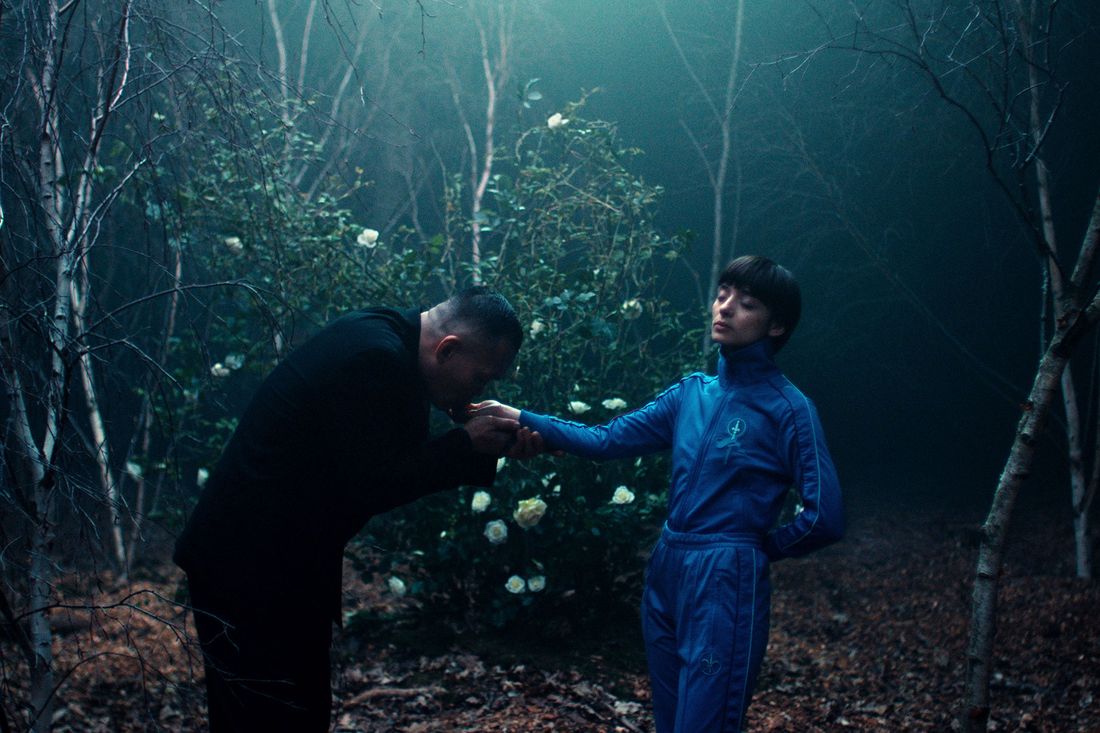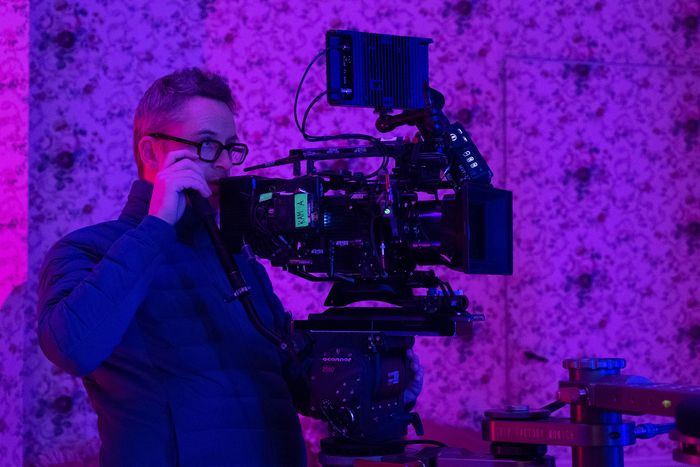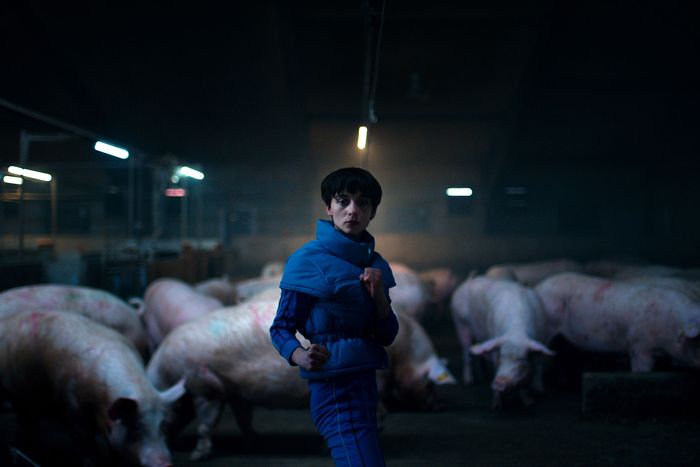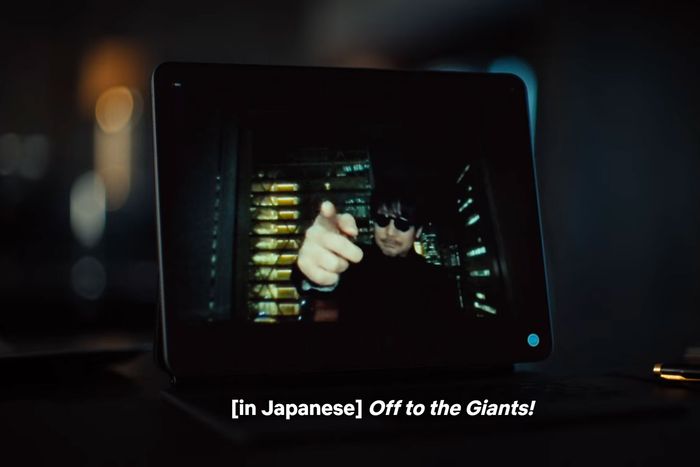
Spoilers follow for all six episodes of the Netflix series Copenhagen Cowboy.
The vengeful heroes of Nicolas Winding Refn’s imagination are contradictions of innocence and violence, near-mythical figures adept at both proffering love and ending life. And until Copenhagen Cowboy, they were almost exclusively men. Refn’s six-part Netflix series plays like a neon-lit remix of his obsessions with authenticity and artifice, parenthood and legacy, and destruction and consumption, this time with a female protagonist at its center: the mysterious Miu (Angela Bundalovic).
“We’re so used to seeing that by men. With women, there weren’t many who didn’t become very similar to what a man would do,” Refn says of pop culture’s long list of solitary, cerebral, blood-spilling avengers. “We wanted something completely removed from man. Miu can make you pregnant, and she can kill you, in the same way a mother has the ability to give birth or kill.”
The six-episode series follows Miu as she wanders Copenhagen, Refn’s hometown and where he got his cinematic start with the Pusher film trilogy, and witnesses myriad instances of gender-based inequity, which compel her to fight against its perpetrators and defend its victims. Refn pulled from fairy-tale lore — the genre’s “bottomless opportunities for human psychology” — and the advancing-levels structure of video games to craft a series of mini arcs that set up new enemies and conflicts for Miu as she “seeks vengeance and purity and puts the world in order,” he says.
All of that leads to finale “The Heavens Will Fall,” which wraps up one story line for Miu, introduces a trio of cliffhangers, and then just … stops. How purposeful was that ambiguity? Refn himself isn’t sure. He has an outline of future adventures for Miu ready to go if “the talk” with Netflix about viewership numbers is promising. (For their part, a Netflix rep confirmed to Vulture that Copenhagen Cowboy is a limited series.) But Refn maintains that a denial of closure was deliberate, a rejection of what he describes as the “limitations of a conventional A-B-C plot” that allowed him to experiment with what kind of ending feels most appropriate for a story, if not necessarily the most immediately fulfilling.
“I wanted to end it at the point where everything was about to change because there is an opportunity for people to dream on,” Refn says. “One of the challenges with content is so much is created just to steal our time. It’s essential that you give an experience in exchange. You may not like it; that’s fine. But it has to be an experience. It has to be something that penetrates you and travels with you for the rest of your life. Sometimes getting everything is not the right answer; it’s what stays with you. The sense of ‘What’s the perfect ending?’ — it can go both ways.”
Miu’s journey: Object to subject.
Miu has one foot in folklore and one in sci-fi, introduced as a “lucky charm” with allegedly magical powers that benefit whoever possesses her. In the premiere, “Miu the Mysterious,” she is purchased by Serbian immigrant and sex trafficker Rosella, who’s convinced Miu’s presence in her home will help her get pregnant — and if she doesn’t, Rosella will sell Miu to the highest male bidder. At first, Copenhagen Cowboy is coy about whether Miu is actually fantastic or simply faking her mystique to manipulate Rosella’s superstitious beliefs. All of Rosella’s other victims believe the latter save one: Cimona (Valentina Dejanovic), who hatches a plan with Miu to escape.
When Cimona disappears, Miu searches the city’s criminal underworld and meets a series of shifty allies including restaurateur and midwife Mother Hulda — who takes in Miu and shares that her daughter, Ai, is being held hostage by an intimidating gangster — and lawyer Miroslav, who is connected to drug dealers, gun smugglers, and, mysteriously, Miu’s past. Refn had changed the series’s concept from a Pusher retread to a more fairy-tale-influenced story and had a broad outline for Miu when the writers’ room met for the first time in December 2020. Series co-developer Sara Isabella Jønsson and the other female writers helped hammer out Miu’s background, obstacles, momentum, and goals, in particular her years of being passed around in the Balkans, the sexual exploitation and abuse she observes in Rosella’s home, and her interactions with her enemies, all of whom covet Miu for a different reason. A guiding question for the room, which Refn discussed with his daughters Lola and Lizzielou, was what women and girls wanted to see in a hero. Their input led to Miu’s healing skills and her growth from an object used by others to a person with her own yearnings, allegiances, and fears.
Refn began shooting in August 2021 and, as his working style, shot in chronological order and tweaked the scripts as he went along. One of his on-set changes involved Miu gaining an alien-abductee backstory, a switch he told Bundalovic right before shooting the scene in the second episode, “Vengeance Is My Name”: “When I was 7 years old, I was kidnapped by aliens,” she reveals. Giving Miu an extraterrestrial element opened up narrative doors for the next four episodes, including her ability to survive extreme weather and the very danger her existence presents to others. (“We didn’t believe you were human … People around you die,” Miroslav tells her.) In addition to drawing inspiration from fairy tales, Refn looked to Joan of Arc, the teenage warrior who believed she heard God and led the French army in his name, for her capability and certainty and selected Miu’s coordinated sweatsuit costume as an homage to her armor.
By the end of “Vengeance Is My Name,” the series is still ambiguous as to whether Miu is a truly mystical “lucky charm,” but her desire for retribution is clear: She helps the sex workers flee their imprisonment and kills Rosella by burning down her house. (Miu’s willingness to be confrontational was inspired by his daughters, Refn says.) The third episode, “Dragon Palace,” sets Miu on the next phase of her journey and builds out the two villains who will dominate the rest of Copenhagen Cowboy: Nicklas (Andreas Lykke Jørgensen), who has a connection to Miu she doesn’t yet know, and the gangster Chiang (Jason Hendil-Forssell), who’s keeping Ai imprisoned and wants to connect with Miu in a way she’d never expect.
Final bosses: Leveling up Miu’s enemies.
The Copenhagen that Miu uncovers is divided along lines of ethnicity and class with misogyny and cruelty its uniting qualities. The series establishes this omnipresent danger before we even meet Miu: In the very first scene of the show, we watch a woman choked to death in a pigpen, her feet shaking in black patent-leather heels and a faceless man’s gloved hands squeezing and gripping her neck, the pigs’ squeals drowning out her screams. At the end of the premiere, that woman and man are revealed to be Cimona and Nicklas, a wealthy serial killer who preys on sex workers and immigrant women and becomes infatuated with Miu. “Dragon Palace” returns to Nicklas with a subplot about his white, blond, old-money vampiric Danish family. Nicklas’s father travels the world teaching people “about the power one has when one possesses a cock,” and Nicklas’s mother is aware of, and encourages, her son’s hunting of women and feasting on their blood; both parents revere their son for how he can propagate their line. The entire subplot feels like Refn winking at critics who dismiss his work as aggressive or toxic; he describes Nicklas’s family’s preoccupation with male genitalia as “absurd.”
Nicklas has never met a foe like Miu, who in “Dragon Palace” accompanies Mother Hulda on her trip to buy a pig from Nicklas’s family and senses Cimona’s spirit near the castle. In the next episode, “From Mr. Chiang With Love,” Miu realizes that Cimona isn’t alone: The pond in which Nicklas dumped her body is full of other women he killed, and their trapped and screaming ghosts propel Miu to fight Nicklas on their behalf. Refn’s 360-degree-revolving camera follows Miu and Nicklas to his family’s pigpen, where Miu beats Nicklas in a graceful, mesmeric duel and leaves his body for the swine to eat. They bite off huge portions of his body, including his penis, and Nicklas seems nullified as a foe, his crimes against women ended by Miu.
Pigs recur throughout Copenhagen Cowboy because of their prominence in fairy tales and Danish culture. Nicklas’s family making their fortune from pig production, a major agricultural industry in Denmark, establishes him as an enemy who believes success is tied to slaughter. (“It was pretty intense shooting at these pig farms,” Refn says. “It messes with your head, the noise.”) The pigs’ voraciousness is also integral to Mother Hulda’s story line; when she gives Miu shelter at her restaurant, Miu learns that the pigs in the back eat corpses delivered by Chiang. Mother Hulda disposes of his enemies’ bodies because Chiang is holding Ai hostage, and Miu agrees to use her superpowers to treat the gangster’s chronic migraines in order to keep Mother Hulda’s daughter safe. “You’re a strange one,” Chiang says, but he grows fascinated by Miu and her inscrutability. When Miu proposes paying a ransom in exchange for Ai’s release, he agrees — and then in the finale, “The Heavens Will Fall,” shocks her by sharing that Ai is his daughter (information Mother Hulda never divulged) and that he’s fallen for Miu romantically (a situation she’s never experienced).
The “unexpected” notion that Chiang propose a sexual relationship and marriage to Miu was episode writer Johanne Algren’s idea, Refn says, and distilled Miu’s discomfiture with human society even as she works to protect its members from each other. “She’d never tried that situation — of almost being human and having to deal with human emotions and somebody that wanted her,” Refn explains. Unnerved and confused by Chiang’s overtures, Miu bleeds for the first time from a pricked finger (à la Princess Aurora in Sleeping Beauty) in their shared dreamscape before accepting his kiss. But how he sucks the blood from her finger evokes Nicklas, so she does what worked with her last enemy: Miu challenges Chiang to a fight.
This duel, set in a room shimmering with fractal beams and accentuated with clattering, reverberating sound effects, distills the series’s mythic ambitions and anti-misogynist subversion, one of the few scenes that were “pretty much written in stone” from the start of the series, Refn says. Miu is the underdog to the physically larger, more imposing Chiang, who swears, “If I cannot have you, I’ll kill you” and tries to choke her, bringing to mind Nicklas’s attack of Cimona and unflagging smothering of women’s voices. Mirrors around the space reflect Chiang but not Miu, hinting at her erasure if he were to win their clash; Refn’s camera whirls as Miu and Chiang punch, parry, reset, and attack until Miu finally adjusts her approach, aims for Chiang’s heart, and punches him over and over until she hears a crack. Chiang’s defeat completes the story line involving himself, Ai, and Mother Hulda, but Refn, continuing his experimentation with gaming narratives, wanted to add “another level” to Miu’s story.
The cliffhangers: Off to the Giants!
Chiang’s vanquishment in “Off to the Giants” would be the ending of another show: a clean conclusion to Miu’s friendship with Mother Hulda, an affirmation of her support of the series’s female characters, and a demonstration of her otherness. But Copenhagen Cowboy keeps going, devoting its last 15 minutes to a trio of cliffhangers: the return of Nicklas and the awakening of his stepsister, Rakel, a fellow vampire; the arrival of multiple Mius; and a cameo from Refn’s friend, video-game designer Hideo Kojima, whose opaque description of characters named “the Giants” ends the season on an audacious note. This final section resembles a proof of concept for a second set of episodes but is also appreciably puzzling on its own, a mic drop as declarative as the other endings in Refn’s filmography — hands chopped off in Only God Forgives, an eaten eyeball in The Neon Demon, and the assassinations of Too Old to Die Young — if not quite as bloody.
Nicklas and Rakel (played by Refn’s daughter Lola) appear together in the fifth episode, “Copenhagen,” with the grievously injured Nicklas asking his spectral sister for help finding and hurting Miu. Refn’s adapt-as-you-go creative style helped construct Rakel and might have been inspired by a fairy tale he remembers his mother reading him as a child: a story about a father and son who travel through space to visit the moon and find a human coffin in a crater. “I don’t know if my mother never finished the story or if I can’t remember what happened. Sometimes I try to fantasize why that coffin was there,” Refn says. Copenhagen Cowboy bears the imprint of his yearslong quest for a conclusion. During production, Refn requested a coffin be placed in the castle’s attic and shot numerous scenes with Nicklas visiting the incongruously glossy box amid the dusty rafters. “Near the end of the shoot, I was like, ‘You know, maybe somebody’s in the coffin, and that should be his sister.’ And everyone was like, ‘Oh, great, yeah, why not?’” Refn describes with a laugh. Rakel’s monstrousness — she eats a dead man’s cooked flesh for her first meal and shoots laser beams out of her eyes — is the opposite of Miu’s persistent empathy, and their contrasting outfits (Miu’s blue to Rakel’s red) underscore their innate antagonism.
As Refn finalized the rivalry between Rakel and Miu, his daughter Lizzielou made a suggestion: What if there were a “mini version” of Miu and “many Mius” who could all team up? Enter Lizzielou as that miniature, whom Bundalovic’s Miu meets after defeating Chiang and returning to Copenhagen’s forested outskirts. A wider group of women — whom Refn considers saints, echoing Miu’s kinship with Joan of Arc — are also scattered throughout the woods with the smaller Miu introducing them to the elder.
“There’s thousands and thousands of her around the world,” Refn explains. “The only line that any of them ever speak is ‘We’ve been waiting for you.’ All these saints have been waiting for her to arrive so they can all move on to the next journey.” As Miu gathers the saints for her next task, she’s interrupted by Rakel emitting a metallic scream from her family’s castle — an unanswered challenge for the titular Copenhagen cowboy that leaves her weeping in despair. Then the episode transitions to its final cliffhanger involving Miroslav and Kojima, whose role Refn describes “as a spiritual advisor from Japan who knows how to deal with these saints.” According to Kojima’s unnamed character, “There’s only one answer: You have to go see the Giants.” Then Copenhagen Cowboy ends without providing a final (or even first) fight between Rakel and Miu and without explaining who or what the Giants represent.
Refn laughs about that abruptness — “I was like, I’m all out of ideas now. Wrap!” — but insists that ending on Rakel’s glowing eyes, Miu’s silent anguish, and Kojima’s emphatic command were all intentional disruptions in service of purposeful unpredictability. What Refn describes as “the origin story of Miu” might continue if Netflix renews the series. But he also thinks there is value in divisiveness, in challenging both narrative form and viewers’ assumptions — a subconscious manifestation of his mother’s unfinished story passed along to Copenhagen Cowboy viewers. In Refn’s fairy tale, “happily ever after” isn’t a guarantee.





